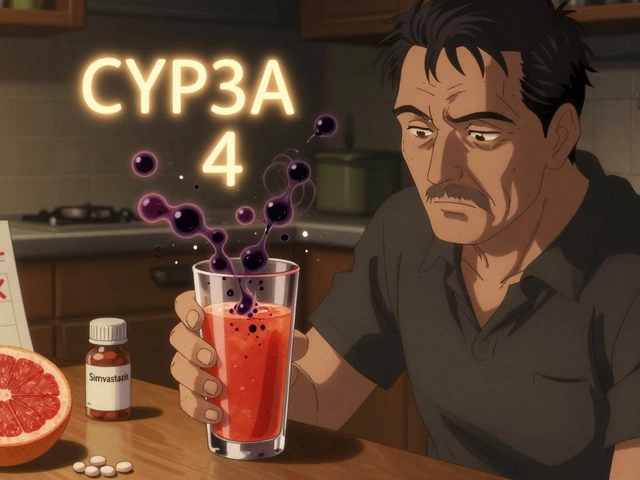If you had told most dermatologists 20 years ago that a simple cream could help treat certain early-stage skin lymphomas, they probably would’ve laughed you out of the office. The idea just sounded too good to be true. Yet here we are: Imiquimod, famous as a wart cream, has unexpectedly found a role in the treatment plan for mycosis fungoides, the most common form of cutaneous T-cell lymphoma. It’s kind of wild how treatments can jump from one disease to another.
What Is Mycosis Fungoides and Why Is Treatment Tricky?
Mycosis fungoides is a rare yet persistent skin lymphoma that often fools people for years. It’s sneaky—early patches and plaques can look like eczema or psoriasis. Doctors sometimes need three or four biopsies over several years before giving you a clear answer. Once you finally hear the name, you might be shocked to learn it’s a type of cancer. But it’s not like the usual idea of cancer; most cases, especially in early stages, move very slowly.
The challenge with treatment? Because it hangs out in the skin, the usual chemotherapy tricks don’t work as well. Most folks with early-stage disease are looking at creams, light therapy, or gentle local treatments instead of hardcore systemic cancer drugs. You don’t want to blast your whole body with side effects if you’re only dealing with a few stubborn patches. That’s where topical treatments like Imiquimod come in.
This disease isn’t common—around one in 100,000 people get diagnosed a year. The National Cancer Institute says that about 70% of cases in the U.S. get caught early, where the disease is limited to the skin. People can live with mycosis fungoides for decades, managing their symptoms with skin-directed therapy. Of course, advanced stages are much tougher to treat and can spread to lymph nodes or organs. But for most people, it’s about keeping those itchy, red patches under control with the fewest side effects possible.
So, what’s the big issue? Traditional steroid creams, phototherapy, and oral retinoids have all been go-to options but don’t always work, and resistance or side effects happen. That’s why doctors and researchers started looking for something new. Enter Imiquimod.
How Does Imiquimod Work—and Why Does It Matter Here?
Imiquimod isn’t a chemotherapy drug, an antibiotic, or even a steroid. It works more like a loud alarm for your immune system. When you dab the cream on your skin, it wakes up immune cells nearby, signaling them to attack anything suspicious—including abnormal T-cells like those in mycosis fungoides lesions.
Sounds science-y, right? Here’s what’s really happening: Imiquimod binds to Toll-like receptor 7 (TLR7) on immune cells. This starts a whole chain reaction of cytokines—think of them as immune text messages—calling for backup. The immune system rushes in, releases interferon-alpha and other signals to help destroy cancerous or virus-infected cells. That’s why Imiquimod’s used for more than just mycosis fungoides. You’ll also find it prescribed for genital warts, superficial basal cell carcinoma, actinic keratosis, and a handful of other tricky skin conditions. This “off-label” use for mycosis fungoides leverages those same superpowers.
Interesting bit: Imiquimod is one of very few creams approved that rely on revving up your own immune defenses. It does not kill cells directly, which makes it less toxic than old-school options. Plenty of doctors like it for this reason—it doesn’t thin your skin like steroids and doesn’t bring the cancer-treatment baggage of chemo.
But, like any weapon, Imiquimod isn’t perfect. Some people get pretty intense local inflammation: redness, stinging, and even blisters. That’s usually a sign it’s revving up your immune system right where you want it. The challenge is finding a balance—enough reaction to help your patches, not so much you can’t function.

Evidence: Does Imiquimod Really Help Mycosis Fungoides?
If you ask around in dermatology circles, you’ll hear a mix of stories—some patients swear by it, some barely get a response. So, what do research studies actually say? There’s not a mountain of big trials, but a steady trickle of case reports, small series, and a handful of review studies. In a 2023 review published in the Journal of the American Academy of Dermatology, about 70% of patients using Imiquimod for early-stage mycosis fungoides had some improvement—whether it was flattening plaques, fading redness, or stopping the itch. That’s pretty promising, especially when you count people who failed steroid creams or light therapy.
Let’s get into numbers. Here’s a quick look at published response rates to Imiquimod for mycosis fungoides (taken from a real-life review):
| Study Year | Number of Patients | Response Rate | Complete Clearance |
|---|---|---|---|
| 2018 | 24 | 70% | 30% |
| 2020 | 17 | 76% | 41% |
| 2023 | 35 | 69% | 34% |
One thing to remember: Most of these successes come from people with early patches or plaques, not folks with “tumor” stage or disease that’s spread to internal organs. The best case is someone with a handful of stubborn patches or plaques close to the skin surface.
Relapses can happen—this isn’t always a forever-cure. But Imiquimod scores points for being easy to use at home and having far fewer risks than systemic treatments. People who’ve tried other skin creams, gotten tired of phototherapy trips, or are worried about steroid side effects often like having another tool like this in their kit.
A few tips from studies and doctors: Applying Imiquimod 2-5 times a week works for most people, but everyone is different. Some patches melt away fast, while others take months of patience. And don’t expect the world overnight. Improvement is slow and steady. Expect a strong redness and tingle—a sign that your immune system is on the move. This isn’t a cream you want to slather everywhere for months without supervision, though—always team up with your dermatologist to keep it safe.
How to Apply Imiquimod for Mycosis Fungoides (and Manage the Side Effects)
So, let’s get practical. You’ve got Imiquimod cream in your hand and a patch of mycosis fungoides staring back. What now? Rule number one: Always follow your doctor’s orders. But in real life, here’s how most people use it:
- Wash the area gently and dry off.
- Apply a thin layer of cream—don’t glob it on—just enough to cover the patch.
- Let it absorb. No need to cover with gauze unless your dermatologist tells you.
- Leave it on for 6 to 10 hours, usually overnight, then wash off with mild soap.
- Repeat 2 to 5 times a week, depending on side effects and results.
Now, about those side effects. Most folks will get a reaction—redness, peeling, itching. It’s like a “good bad sign”—you want some irritation, not a chemical burn. If the skin is blistering or oozing, pull back and talk to your doctor. Sometimes less is more. You can reduce use for a while, then ramp up if tolerated.
Dryness or soreness? Keep some gentle moisturizer handy—but ask your doctor which kind is OK. Avoid heavy ointment that could trap the medicine or block it from soaking in.
Here’s one practical tip straight from patients: If you put Imiquimod on at night, you sleep through the worst of the tingle and are less tempted to scratch. Smart, right?
Keep an eye out for broader side effects, like fever or fatigue. These are really rare in people just treating a few skin patches. If you notice something that doesn’t feel right or if you’re worried, just reach out to your healthcare team.
Another thing to keep in mind: Some people are more sensitive than others. If your skin tends to react fast, or if you have other immune problems, talk this over with your dermatologist. They might want to start you slow and watch closely for a couple of weeks.

Tips and Real-Life Insights for Patients and Caregivers
Using Imiquimod for mycosis fungoides isn’t just about dabbing cream. You’re dealing with a skin problem that’s…well, it’s cancer, but it doesn’t always feel like it. That can mess with your head. It helps to go in with your eyes open and a few useful tricks in your back pocket.
- Be patient: This treatment takes time. Results come in weeks, not days. Take photos to track progress, because the slow improvement can be tough to spot in the mirror.
- Don’t chase perfect: Sometimes, patches fade but don’t totally disappear. If things improve and stop itching or burning, that’s a win.
- Pace yourself: It’s tempting to use more if you think it’s working, but you can actually irritate your skin so much it backfires. Stick to your routine.
- Talk about it: If you notice mood changes, more fatigue, or feel isolated, you’re not alone. Plenty of people with skin lymphomas feel “invisible” and dismissed—reach out to online support groups for company and advice.
- Ask for help when needed: Sometimes, mixing therapies or rotating creams works best. Don’t be afraid to bring up new ideas with your care team.
- Protect that skin: Avoid direct sun exposure on treated areas, since Imiquimod can make you more prone to sunburn. SPF and gentle coverage are your friends.
- Store wisely: Keep the cream at the right temperature—most brands need room temp, not in the fridge.
Here’s something hopeful: For many people, Imiquimod means fewer trips to the clinic, more freedom, and better day-to-day life. The idea that a simple cream, applied at home, can help you kick back some of those stubborn, confidence-shaking patches? That’s worth celebrating.
Always remember, you’re teaming up with science—and with your dermatologist. New studies are always in the pipeline, so watch for updates as we learn even more. For now, Imiquimod stands out as an option that keeps things simple, manageable, and, for many, surprisingly effective.








Anoop Choradia July 17, 2025
The therapeutic potential of Imiquimod in the treatment of mycosis fungoides indeed presents itself as a rather intriguing subject within the dermatological oncology sphere. The mechanistic action of Imiquimod, as a toll-like receptor 7 agonist, indeed facilitates an enhanced immunomodulatory response which ostensibly contributes to its efficacy in this context. However, one must remain cautious in interpreting the extant clinical data, given the relative paucity of large-scale randomized controlled trials that definitively substantiate its broad-spectrum applicability.
Moreover, the nuanced side effect profile and patient adherence parameters warrant thorough examination. It is paramount to consider whether the observed therapeutic indexes justify any detriments to quality of life stemming from dermal irritation or systemic symptoms. On a methodological front, I implore further elucidation on the criteria employed in assessing response rates, as such details critically influence the validity of any conclusions drawn therein.
In summation, while this article commendably consolidates current insights, a more rigorous evidence framework is necessitated before unequivocal endorsements of Imiquimod in the mycosis fungoides treatment algorithm can be promulgated.
bhavani pitta July 20, 2025
Honestly, I remain skeptical about these touted benefits of Imiquimod for mycosis fungoides. Not that it's ineffective but the hype sometimes seems disproportionate to the actual outcomes reported in practice. The article covers the facts perfectly well but one feels some critics are glossing over the variability of patient reactions to this treatment.
And let's not forget the emotional toll and the discomfort that the application of such creams often bring. Sometimes, the side effects are so bothersome that patients feel psychologically burdened, and such aspects are hardly given their due weight in medical discussions. I think a balanced narrative should include these patient-centered perspectives to avoid painting an overly optimistic picture.
Plus, adherence can be a real challenge when creams cause irritation over time. It's not just about the scientific evidence but also about how real people live through this therapy, and I think that nuance is missing.
Brenda Taylor July 22, 2025
So I've seen some folks here already diving deep into the science but seriously, can anyone speak on the real-world day-to-day usability of Imiquimod? Like, how manageable are those side effects in the long run? I think it's a big deal to know if this cream is more hassle than helpful because if it burns or itches all the time, that’s rough :(
I also wonder if anyone’s tried combining this with other treatments and what that experience was like? There isn’t much chatter about patient lifestyle adjustments or how long before folks start seeing results either. Feels like this info gap makes it hard for people to get a full picture when deciding.
Would love some pros and cons from actual patients or caregivers if anyone is around!
virginia sancho July 24, 2025
Hey all, I’ve been working with patients using Imiquimod for mycosis fungoides, so I thought I’d chime in with some practical insights that might help. First off, the application needs to be consistent but gentle — over-application can lead to significant irritation, which can deter patients from sticking with the treatment regimen.
Side effects like redness, scabbing, and mild swelling are common, but typically manageable with proper skin care routines and moisturizers. A lot of folks doing well incorporate cold compresses and avoid sunlight exposure to reduce complications. The key is individualized management; every patient reacts differently.
Results can appear within a few weeks, though substantial improvement usually takes a few months. Patience is crucial. Also, combining topical therapy with phototherapy or systemic treatments can sometimes boost outcomes but requires close supervision. If you’re thinking about this treatment, talk through all options with your healthcare provider and prepare for a gradual process.
Namit Kumar July 26, 2025
Really appreciate the detailed breakdowns here, especially the medical insights. In my experience, the emergence of treatments like Imiquimod represents a breakthrough that the medical field should prioritize more aggressively. It’s fascinating how immune modulation is an evolving frontier in tackling skin lymphoma, and this cream reinforces that potential.
Of course, we must be vigilant about the regulatory and accessibility hurdles, especially in countries like India where patient access can be uneven. Ensuring affordability and education about the application might be just as critical as the medicine’s chemistry itself. Let's also not ignore the emotional and societal support structures necessary for comprehensive care.
Imiquimod’s relative simplicity as a topical offers convenience, but let’s bear in mind the cultural and systemic factors influencing adherence and outcomes in real-world scenarios.
Sam Rail July 28, 2025
Thanks for shedding some light on this topic, it’s honestly not something I’d heard much about before. I guess Imiquimod is another tool in the toolbox, right? From what I gather, it sounds promising but like others mentioned, it’s not a miracle cure. Plus, the side effects sound like they could be a pain to deal with.
Has anyone noticed big differences between using the cream only versus combining it with other treatments? Also, does anyone know if it’s covered by most insurance plans or is it expensive to get a prescription filled?
Would be great to hear some simple pros and cons from people who have tried it or from doctors who prescribe it often. Thanks!
Taryn Thompson July 31, 2025
This article really resonates with me since I've guided many patients through Imiquimod treatment plans. The truth is, success with this therapy heavily depends on close monitoring and patient education. It's not just about slapping on the cream; it's about recognizing when to adjust usage or pause to allow the skin to heal.
One tip I always stress: keep a symptom diary and communicate openly with your healthcare provider. Some patients worry about persistent redness and stop treatment prematurely, but understanding what's normal versus hazardous skin reaction helps them stay the course.
Overall, Imiquimod holds promise but requires partnership between patient and practitioner. The article is spot on in highlighting its growing role but I’d add that tailored, continuous support makes all the difference in outcomes.
Lisa Lower August 2, 2025
Omg I needed this article today because this treatment stuff is so confusing sometimes and like, reading all the studies makes my head spin. But Imiquimod... it kinda sounds like a hope thing with some bumps in the road because of side effects? Honestly, I'm always for pushing through challenges, but I wonder if some people bail early because the cream irritates too much.
Still, the fact that it’s topical and not systemic sounds way better than chemo for sure. And apparently patience is everything here, which makes sense but is also kinda terrifying for people who want faster results. Has anyone here heard of weird reactions or people needing to stop it completely? Can be scary as hell
Anyway, I’m rooting for everyone dealing with this, it sounds tough and complicated but you’re definitely not alone!
Dana Sellers August 4, 2025
Seriously, why is everyone so obsessed with Imiquimod? Like yeah it has some effect but it’s all just hype pushed by big pharma and their sneaky marketing. People just want miracles and this cream is supposed to be it? Nah, that’s just lazy thinking. You gotta fight cancer with strength and not rely on some cream that makes your skin burn and peel.
I bet they’re hiding the real stats about how many patients fail this treatment. And then there's the side effect mess that barely gets talked about – like people should just suck it up? No thanks. Where’s the focus on real cures and not these fancy immunomodulators that just enrich drug companies.
Wake up folks, don’t let yourself get sold a pipe dream without questioning the whole picture!
Damon Farnham August 6, 2025
Ironically, while some complain about the cream, we should acknowledge that immunomodulating therapies like Imiquimod are genuinely innovative. Not everyone has the luxury of aggressive systemic therapies, and topical options like this can be a godsend. I do concede the side effects can feel harsh, but the tradeoff in localized treatment often outweighs the negatives.
Also, it’s impressive how this opens doors for patients who might otherwise have limited options. There’s always room for improvement, but dismissing it outright is unproductive. A meticulous but progressive attitude is better suited for tackling diseases as complex as mycosis fungoides.
Let’s celebrate advancements instead of tearing them down due to discomfort or inconvenience.
Gary Tynes August 8, 2025
Hey all, I just wanted to add a little perspective from working with folks who have used Imiquimod. It’s always a mixed bag — some patients see marked improvements, some struggle with the irritation, and a few don’t respond much at all. The key really is managing expectations and starting slow to gauge skin reactions.
Also something that’s not often mentioned but is super important — mental health support while on treatments like this. The frustration of persistent skin symptoms plus the emotional weight of lymphoma can be overwhelming.
If anyone here is considering or undergoing treatment, reach out for help on both fronts, medical and emotional. It’s not just about the cream but overall well-being. I’m rooting for everyone on this journey!